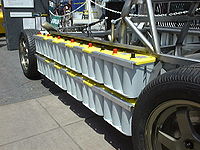
Battery pack
Encyclopedia

Battery (electricity)
An electrical battery is one or more electrochemical cells that convert stored chemical energy into electrical energy. Since the invention of the first battery in 1800 by Alessandro Volta and especially since the technically improved Daniell cell in 1836, batteries have become a common power...
or individual battery cells. They may be configured in a series, parallel or a mixture of both to deliver the desired voltage, capacity, or power density. The term battery pack is often used in reference to RC hobby toys and battery electric vehicle
Battery electric vehicle
A battery electric vehicle, or BEV, is a type of electric vehicle that uses chemical energy stored in rechargeable battery packs. BEVs use electric motors and motor controllers instead of, or in addition to, internal combustion engines for propulsion.A battery-only electric vehicle or...
s.
Components of battery packs include the individual batteries or cells, and the interconnects which provide electrical conductivity between them. Rechargeable battery packs often contain a temperature sensor, which the battery charger uses to detect the end of charging. Interconnects are also found in batteries as they are the part which connects each cell, though batteries are most often only arranged in series strings.
When wiring a pack in parallel there are various methods and one should take into consideration the balance of the electrical circuit. Battery regulators are sometimes used to keep the peak voltage of each individual battery or cell below its maximum value so to allow weaker batteries to be fully charged, bringing the whole pack back into balance. Active balancing can also be performed by battery balancer devices which can shuttle energy from strong batteries to weaker ones in real time for even better balance. A well-balanced pack lasts longer and delivers better performance so it is a rather beneficial component of high capacity or expensive packs.
For an inline package, cells are selected and stacked with solder in between them. The cells are pressed together and a current pulse generates heat to solder them together and to weld all connections internal to the cell.
Calculating State Of Charge
SOC or State of charge is the equivalent of a fuel gaugeFuel gauge
A fuel gauge is an instrument used to indicate the level of fuel contained in a tank. Commonly used in cars, these may also be used for any tank including underground storage tanks.As used in cars, the gauge consists of two parts:...
for a battery. SOC cannot be determined by a simple voltage measurement, because the terminal voltage of a battery may stay substantially constant until it is completely discharged. In some types of battery, electrolyte specific gravity
Specific gravity
Specific gravity is the ratio of the density of a substance to the density of a reference substance. Apparent specific gravity is the ratio of the weight of a volume of the substance to the weight of an equal volume of the reference substance. The reference substance is nearly always water for...
may be related to state of charge but this is not measurable on typical battery pack cells, and is not related to state of charge on most battery types. Most SOC methods take into account voltage and current as well as temperature and other aspects of the discharge and charge process to in essence count up or down within a pre-defined capacity of a pack. More complex state of charge estimation systems take into account the Peukert effect
Peukert's law
Peukert's law, presented by the German scientist W. Peukert in 1897, expresses the capacity of a lead–acid battery in terms of the rate at which it is discharged. As the rate increases, the battery's available capacity decreases....
which relates the capacity of the battery to the discharge rate.
Advantages
An advantage of a battery pack is the ease with which it can be swapped into or out of a device. This allows multiple packs to deliver extended runtimes, freeing up the device for continued use while charging the removed pack separately.Another advantage is the flexibility of their design and implementation, allowing the use of cheaper high-production cells or batteries to be combined into a pack for nearly any application.
At the end of product life, batteries can be removed and recycled separately, reducing the total volume of hazardous waste.
Disadvantages
Packs are often simpler for end users to repair or tamper with than a sealed non-serviceable battery or cell. Though some might consider this an advantage it is important to take safety precautions when servicing a battery pack as they pose a danger as potential chemical, electrical, and fire risks.See also
- Battery balancer
- Battery chargerBattery chargerA battery charger is a device used to put energy into a secondary cell or rechargeable battery by forcing an electric current through it.The charge current depends upon the technology and capacity of the battery being charged...
- Battery Management SystemBattery Management SystemA battery management system is any electronic system that manages a rechargeable battery , such as by monitoring its state, calculating secondary data, reporting that data, protecting the battery, controlling its environment, and / or balancing it.-Monitor:A BMS may monitor the state of the...
(BMS) - Battery monitoring
- Battery regulator
- Smart Battery Data
External links
- Battery Monitor - Bar Graph
- BMS:
- BMS Concepts
- http://patimg1.uspto.gov/.piw?docid=US005710504&SectionNum=1&IDKey=848FB6E63FD1&HomeUrl=http://patft1.uspto.gov/netacgi/nph-Parser?Sect1=PTO2%2526Sect2=HITOFF%2526p=1%2526u=%25252Fnetahtml%25252FPTO%25252Fsearch-bool.html%2526r=25%2526f=G%2526l=50%2526co1=AND%2526d=PTXT%2526s1=5,710,504%2526OS=5,710,504%2526RS=5,710,504Capacitive BMS (doubleplus good, although I haven't had time to find who makes them)]
- And Victor made a good shot at a BMS, and actually -shares- his info (unusual)
- Individual cell monitor
- Electric Vehicle Battery Pack Test System

